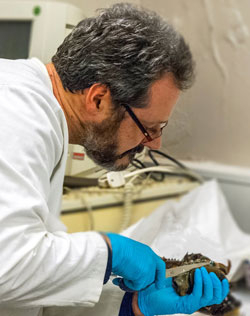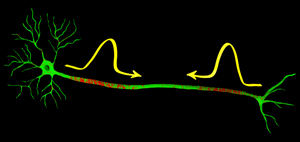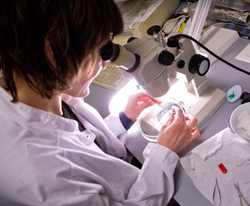Nerve impulses can collide and continue unaffected
According to the traditional theory of nerves, two nerve impulses sent from opposite ends of a nerve annihilate when they collide. New research from the Niels Bohr Institute now shows that two colliding nerve impulses simply pass through each other and continue unaffected. This supports the theory that nerves function as sound pulses. The results are published in the scientific journal Physical Review X.

Alfredo Gonzales-Perez, postdoc in the Membrane Biophysics Group. Here, he is in the process of dissecting a lobster to remove nerves for the experiments. (Credit: Andrew Jackson, NBI)
According to the traditional theory of nerves, two nerve impulses sent from opposite ends of a nerve annihilate when they collide. New research from the Niels Bohr Institute now shows that two colliding nerve impulses simply pass through each other and continue unaffected. This supports the theory that nerves function as sound pulses. The results are published in the scientific journal Physical Review X.
Nerve signals control the communication between the billions of cells in an organism and enable them to work together in neural networks. But how do nerve signals work?
Old model
In 1952, Hodgkin and Huxley introduced a model in which nerve signals were described as an electric current along the nerve produced by the flow of ions. The mechanism is produced by layers of electrically charged particles (ions of sodium and potassium) on either side of the nerve membrane that change places when stimulated. This change in charge creates an electric current.
This model has enjoyed general acceptance. For more than 60 years, all medical and biology textbooks have said that nerves function is due to an electric current along the nerve pathway. However, this model cannot explain a number of phenomena that are known about nerve function.
New model
Researchers at the Niels Bohr Institute at the University of Copenhagen have now conducted experiments that raise doubts about this well-established model of electrical impulses along the nerve pathway.
“According to the theory of this ion mechanism, the electrical signal leaves an inactive region in its wake, and the nerve can only support new signals after a short recovery period of inactivity. Therefore, two electrical impulses sent from opposite ends of the nerve should be stopped after colliding and running into these inactive regions,” explains Thomas Heimburg, Professor and head of the Membrane Biophysics Group at the Niels Bohr Institute at the University of Copenhagen.

The illustration shows two nerve signals passing through each other completely unhindered. This confirms the theory that the signal is made up of waves in the form of a sound pulse, a soliton, which moves along the nerve membrane. As the sound pulse moves along the nerve pathway, the membrane changes locally from liquid (green) to more solid (red) form. The membrane is slightly compressed, and a voltage pulse is produced by the piezoelectric effect. (Credit: Marie Dyekjær Eriksen, NBI)
Thomas Heimburg and his research group conducted experiment in the laboratory using nerves from earthworms and lobsters. The nerves were removed and used in an experiment which allowed the researchers to stimulate the nerve fibres with electrodes on both ends. Then they measured the signals en route.
“Our study showed that the signals passed through each other completely unhindered and unaltered. That’s how sound waves work. A sound wave doesn’t stop when it meets another sound wave. Both waves continue on unimpeded. The nerve impulse can therefore be explained by the fact that the pulse is a mechanical wave in the form of a sound pulse, a soliton, that moves along the nerve membrane,” explains Thomas Heimburg.

Rima Budvytyte, postdoc in the Membrane Biophysics Group. She is preparing the nerve to be used for the experiments. (Credit: Ola Jakup Joensen, NBI)
The theory is confirmed
When the sound pulse moves through the nerve pathway, the membrane changes locally from a liquid to a more solid form. The membrane is compressed slightly, and this change leads to an electrical pulse as a consequence of the piezoelectric effect.
“The electrical signal is thus not based on an electric current but is caused by a mechanical force,” points out Thomas Heimburg.
Thomas Heimburg, along with Professor Andrew Jackson, first proposed the theory that nerves function by sound pulses in 2005. Their research has since provided support for this theory, and the new experiments offer additional confirmation for the theory that nerve signals are sound pulses.

Professor Thomas Heimburg, professor og leder af Membran Biofysik-Gruppen på Niels Bohr Institutet, Københavns Universitet, 3532-5389, 2629-5233, theimbu@nbi.dk
